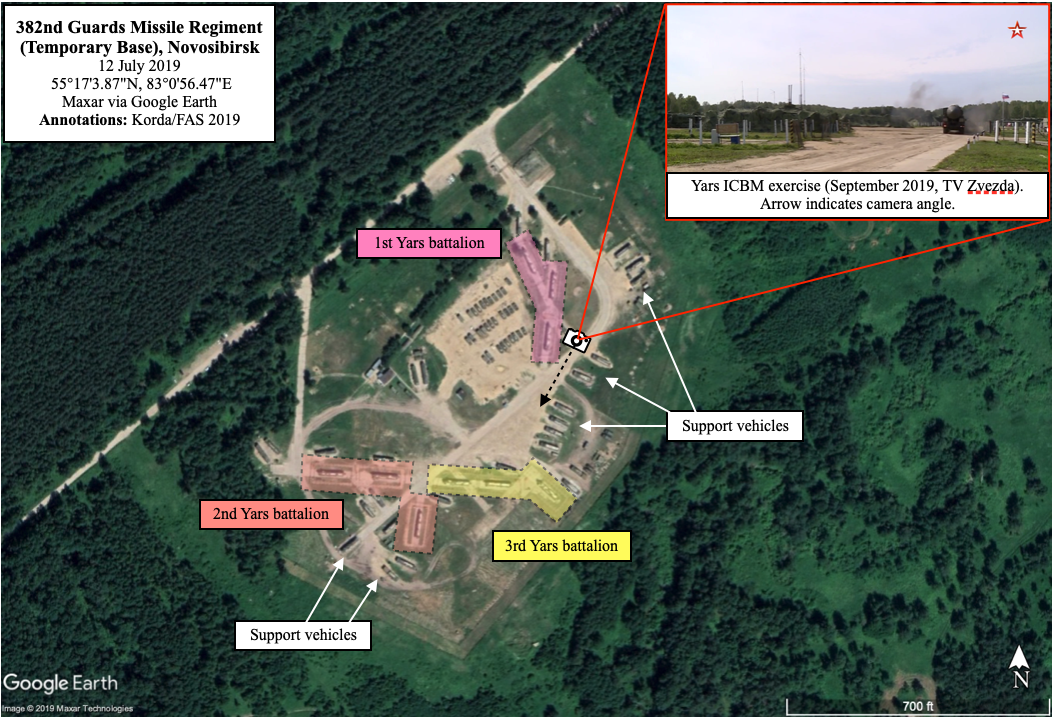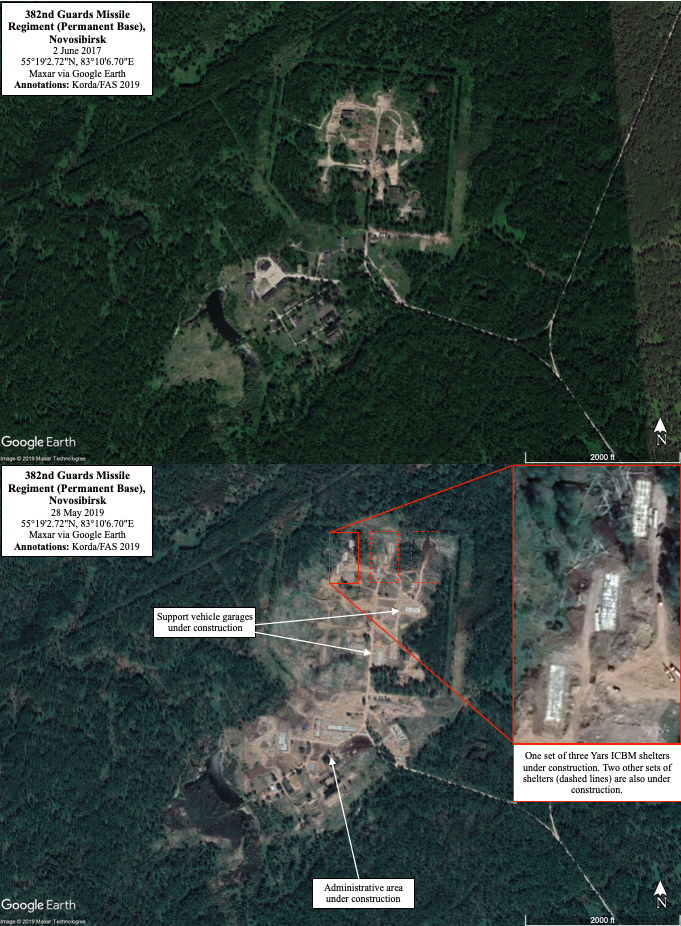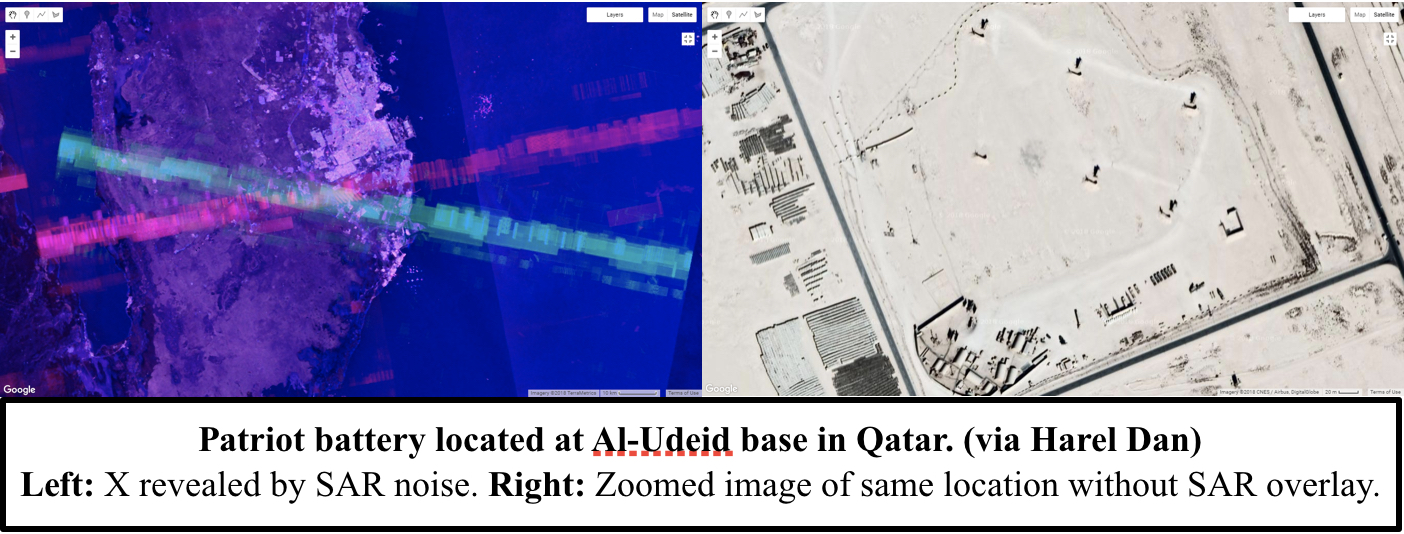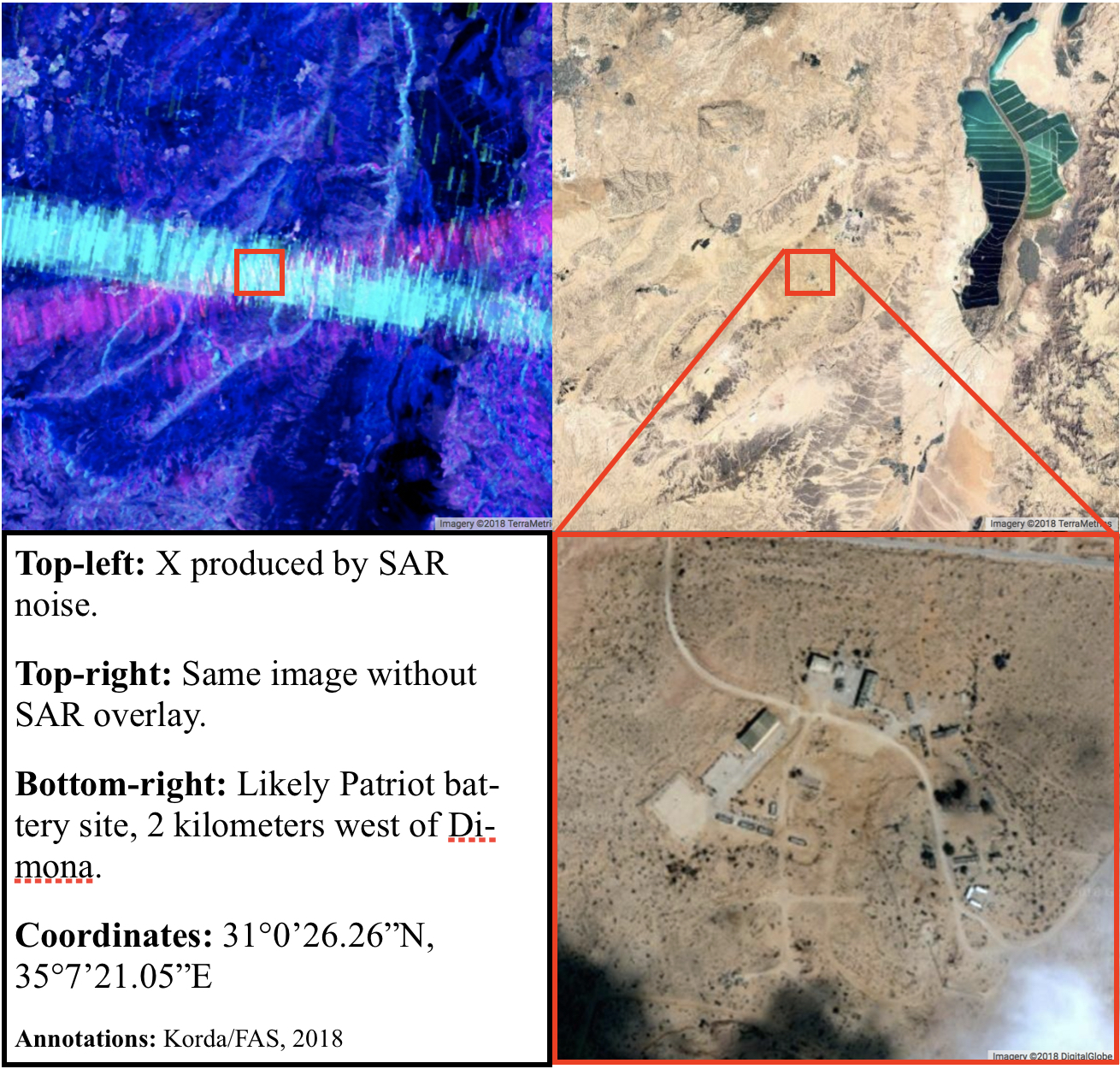Raising the Nuclear IQ
Today is the release of “The Next Nuclear Age” series on the Washington Post.
Q: Your team has a new series on the Washington Post. Can you tell us a bit about what you will be talking about in this series? A sneak peek, if you will.
Hans Kristensen: The world is changing, and it’s changing fast. And we have been working on nuclear security issues for 80 years. And I started working on this in the 1980s, I grew up in the Cold War in Europe. We had this period post-Cold War, of peace and getting together to solve problems. Now it’s changing. The world’s gotten more dangerous. And it’s happening fast. And we want with this series to draw attention to what some of those features are: what are some of the things that are driving this change? That comes an increase in nuclear risks, the risk that nuclear weapons could come into use. The risk that countries begin to build more of them, operate them more offensively, etc, etc. So there are lots of things at stake.
Q: How did this series come to be, and how has this process differed for your team compared to your previous experience in conducting research and reporting on it?
Hans Kristensen: We publish very detailed overviews of nuclear powers [in the Nuclear Notebook], what they do, and their programs. But this particular series in the Washington Post came to be because of the need to communicate to a broader audience. So you can’t get too lost in all the technical details. You have to be able to tell a story, and so we did that and picked a handful of key different aspects of the nuclear problem. And so we hope this comes across as a story about these immense challenges that are facing humanity right now.
Q: Hans, you have been working on the Nuclear Information Project for almost two decades. How has the work evolved since you’ve joined?
Hans Kristensen: FAS was a natural place to go with this project because it was founded by the people who developed the first nuclear weapon and have been in the nuclear business, limiting nuclear risks for all these decades. Later, I came in with the Nuclear Information Project 20 years ago, and for the longest time, it was just little me sitting here working on that, with a few grants. That sort of barely kept me going. As the world began to change, opportunities for funding increased, and we’re able to hire more staff. So now we’re fortunate enough to have six people who are working on this project. And these are people with a very broad range of skills. Everything from deep inside government experience to sort of activism, journalism types of experiences to academic or international organizations experience. It’s a really interesting spread of people that also goes really far in age. We go from early twenties, all the way up to the early sixties.
Q: How have public attitudes and policy frameworks on nuclear weapons shifted since you began working in this space?
Hans Kristensen: Back in the eighties, there was an upswelling of public opposition to nuclear weapons. And people today don’t really believe it, and certainly haven’t experienced it. Most people haven’t experienced it, but we had millions of people, ordinary people, in the streets of Central Park and massive demonstrations across Europe. All the time, people were afraid that our leaders were taking us down a dangerous path. And so they objected and demonstrated. Then the Soviet Union fell apart, and the Cold War ended, and for a period during the nineties, everything sort of got better, and we thought the issue of nuclear would sort of fade more and more into the background, and for sure, there were enormous changes. Since then, I mean, enormous amounts of nuclear weapons were just basically caught up and thrown away. But gradually, this picture started changing, and the political climate soured. We got into skirmishes with each other and and a sort of Cold War attitude returned. But today, most people are sort of still living in the past, meaning the 1990s. “Thinking that there’s this stuff going on doesn’t look good, and whatever. But it doesn’t really affect me personally.” So there’s much less public engagement on this today. It’s not necessarily something that’s going to stay that way. It could be that nuclear risks increase further, and it’s very likely that if they do, there will be much more pressure on politicians from the public
Q: During the freeze movement, there was a lot of public attention on nuclear weapons. Although the total number has decreased, weapon types have evolved. Is there awareness that, despite having fewer nuclear weapons than during the arms race, these weapons remain highly dangerous and are modernizing?
Hans Kristensen: Yes, this is one of the challenges of describing what is happening right now, because people tend to compare it with the Cold War. But the Cold War was particularly nasty. It was the intensity of a global Cold War that was happening all the time. Nukes were everywhere. I mean, they were deployed everywhere. It was extraordinary. That’s no longer the case. That’s the good news. And so the kind of challenge we are now facing is. Yes, there is an increase in nuclear weapons in some countries, but it’s not nearly at the pace of the Cold War. Today, the danger is that we get into these interactions where nuclear weapons are playing a bigger and bigger role. And there are more countries who have nuclear weapons, and more countries in the future will choose to get nuclear weapons. And so the pathways to the potential use of nuclear weapons have increased more than the number of nuclear weapons.
Q: Who do you most hope engages with this series, and what do you hope they take away?
Hans Kristensen: We want them to come out of it with a raised nuclear IQ, that gives them a broader picture, sort of in a concentrated framework, to be able to relate to this nuclear challenge we have today. And we certainly hope that people will be motivated to contact their congresspeople, write articles, and engage with other people. The whole shebang about how to influence public policy. But it’s also a debate for people who are in government, because many people who are in government today don’t have any Cold War experience. And so they were young people who came in. They don’t have that personal background. They need to be educated about this as well. So it’s really a series of articles that has to span widely and reach a very broad range of people from different backgrounds.
Q: What makes this series especially timely, given the growing disregard for information?
Hans Kristensen: It’s the importance of putting out information about these issues, to raise the nuclear IQ with people. Without information, without factual information, you can’t act. You can’t relate to the world you live in. And so it’s super important for us to be able to monitor what’s happening around the world, analyze the material, and translate it into something that different audiences can understand. So we’re fortunate enough that our material here on the project is being used around the world all the time. I mean, our factual pieces are used as the basis for newspaper articles, television shows, books, magazines, conversations, and briefings around the world. So it’s an extraordinarily privileged situation to be in, to be able to contribute and empower the public debate with facts.
Biden Administration Decides To Build A New Nuclear Bomb to Get Rid Of An Old Bomb
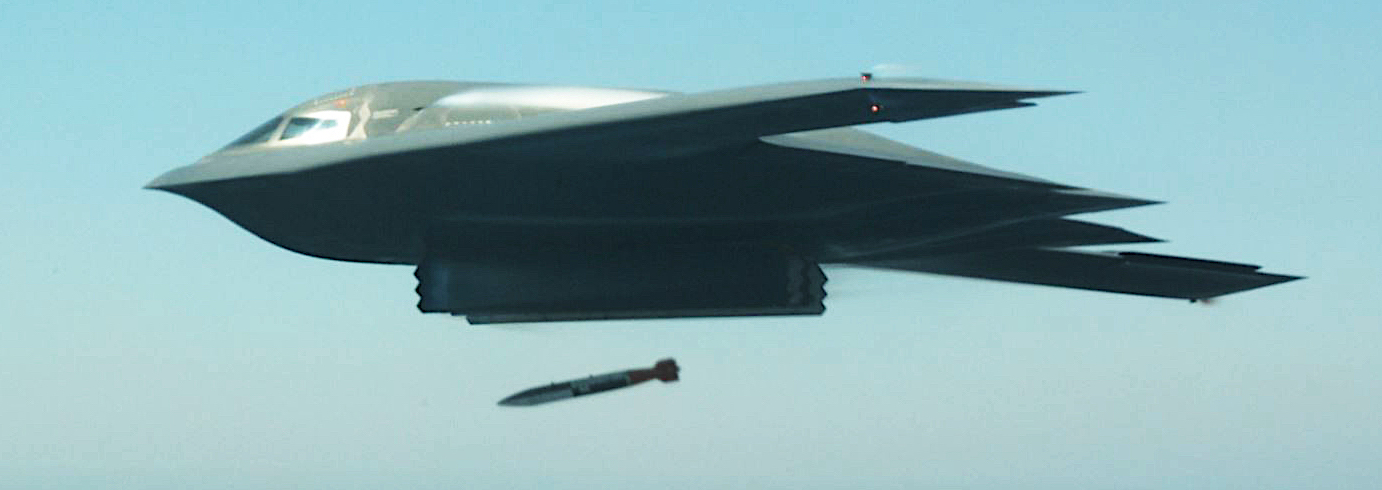
A B-2 bomber drops an unarmed B61-12 bomb in a trial. The planned B61-13, which seems intended to persuade Congress to allow retirement of the B83-1, would look the same and arm the new B-21 bomber.
[UPDATED] The Biden administration has decided to add a new nuclear gravity bomb to the US arsenal. The bomb will be known as the B61-13.
The decision to add the B61-13 comes shortly after another new nuclear bomb – the B61-12 – began full-scale production last year and is currently entering the nuclear stockpile. The administration stated that it would not increase the number of weapons in the arsenal and that any B61-13s would come at the expense of the long-planned B61-12.
According to defense officials, the B61-13 will use the warhead from the B61-7 but will be modified with new safety and use-control features as well as a guided tail kit (like the B61-12) to increase the bomb’s accuracy compared with the B61-7.
Although officials assured us that the B61-13 plan is not due to new developments in the target set, the press material from the Pentagon is more direct: B61-13 will “provides us with additional flexibility” by “providing the President with additional options against certain harder and large-area military targets.”
Like the B61-7, the B61-13 will be designed for delivery by strategic bombers: the future B-21 and, until it is retired, possibly also the B-2. It is not intended for delivery by dual-capable fighters. This decision to build the B61-13, however, appears to have less to do with a military need than striking a political deal to get rid of the last megaton-yield weapon in the US arsenal: the B83-1. This weapon was originally slated for retirement under President Obama until it was resurrected by the Trump administration; it has since become a focal point of the battle between the Biden administration, which wants to retire it, and congressional hardliners, who want to keep it.
Change Of Plan
The case for the B61-13 is strange. For the past 13 years, the sales pitch for the expensive B61-12 has been that it would replace all other nuclear gravity bombs. By re-using the B61-4 warhead, adding new safety and use-control features, and increasing accuracy with a guided tail kit, the agencies initially argued that it would be a consolidation of four existing types (B61-3/4/7/10) into a single type of gravity bomb.
Military officials have explained countless times that the B61-12 would be able to cover all gravity missions with less collateral damage than large-yield bombs. Increasing the bomb’s accuracy was the key reason why the tail kit was added, replacing the older drag parachute system of the older weapons.
By reducing the number of bomb types, the administration argued, it would be possible to reduce the total number of gravity bombs in the arsenal by 50 percent and save a substantial amount of money. Moreover, by using a warhead for the B61-12 with the least amount of fissile material, the proliferation risk from theft would be reduced, so the argument went. When the B61-10 was retired in 2016, the pitch obviously changed to consolidating three bomb types, rather than four, into one. But the Obama administration also wanted to use it to replace the ultra-high yield B83-1 and eventually the B61-11 earth-penetrator.
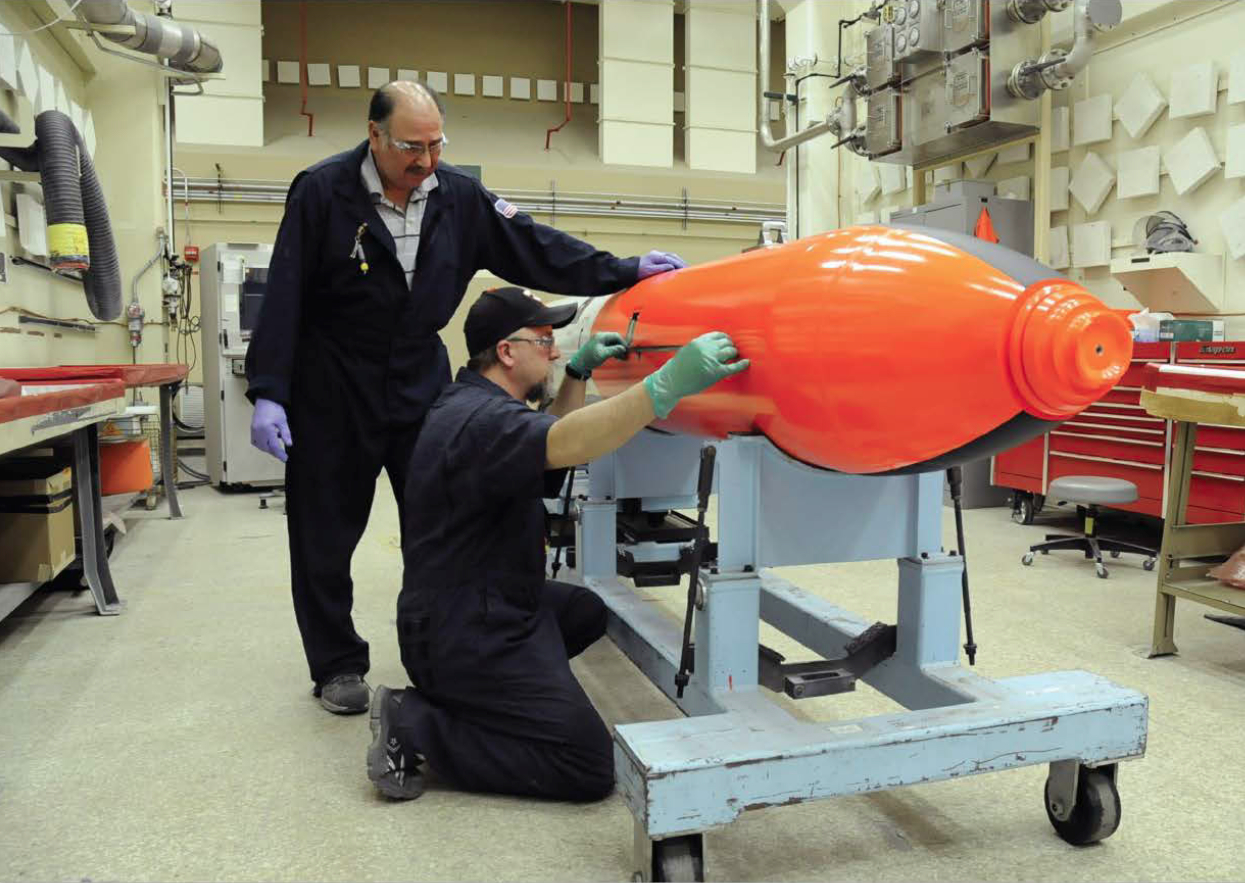
The Biden administration appears to have decided to build the new B61-13 nuclear bomb to persuade hardliners to get rid of the old B83-1 bomb.
The Trump administration had different interests, however, and its Nuclear Posture Review decided to retain the B83-1 (for reasons that remain unclear, and appear to have as much to do with undoing any decisions from the previous administration and little to do with military requirements or target sets) and leave the fate of the B61-11 unanswered.
When the Biden administration took over, its Nuclear Posture Review decided to proceed with retirement of the B83-1 but did not say anything about the B61-11. The Republican-controlled House did not agree and have used the years since to solicit hardline views that the B83-1 is somehow still needed.
Privately, however, Air Force and NNSA official disagreed. A high-yield gravity bomb is no longer needed and maintaining the B83-1 would cost a lot of money that could be better used elsewhere. Moreover, the NNSA production schedule is packed and adding a B83-1 life-extension program could jeopardize much more important programs. Although the B61-13 will add stress to this backlog, it will not increase the NNSA’s planned plutonium pit production schedule.
B61-13 Characteristics
Confusingly, the name B61-13 has already been used for another nuclear weapon: the future bomb intended to replace the B61-12 in the late-2030s and 2040s. That weapon was first described in NNSA’s Stockpile Stewardship and Management Plan in 2015 (see images below).
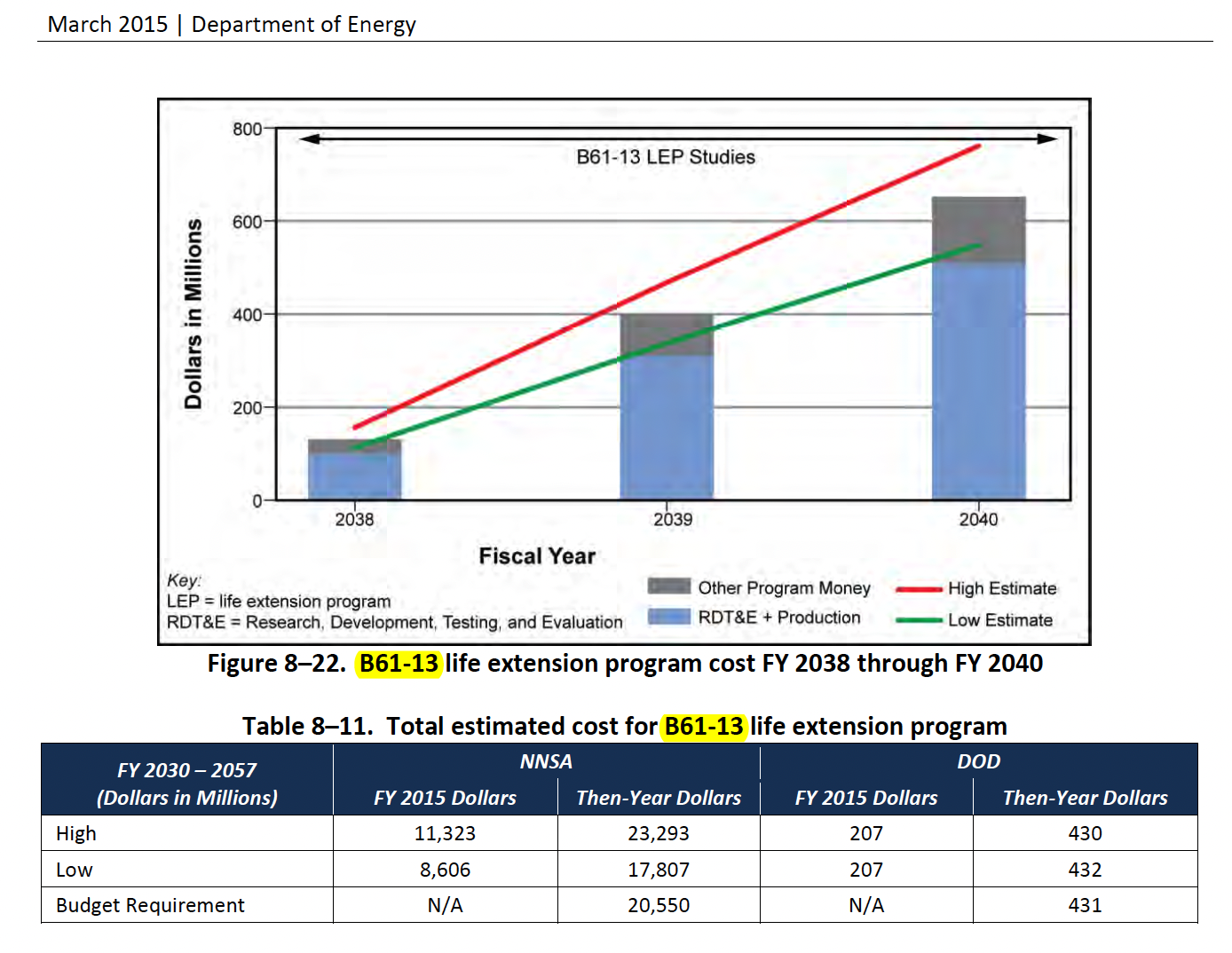
The B61-13 designation was previously given to another future nuclear bomb back in 2015.
The new B61-13 bomb will be the 13th modification of the B61 warhead design (see image below). These modifications have varied in physical appearances, yields, safety and use-control features, and delivery platforms. Five of these modifications remain in the stockpile (B61-3/4/7/11/12).
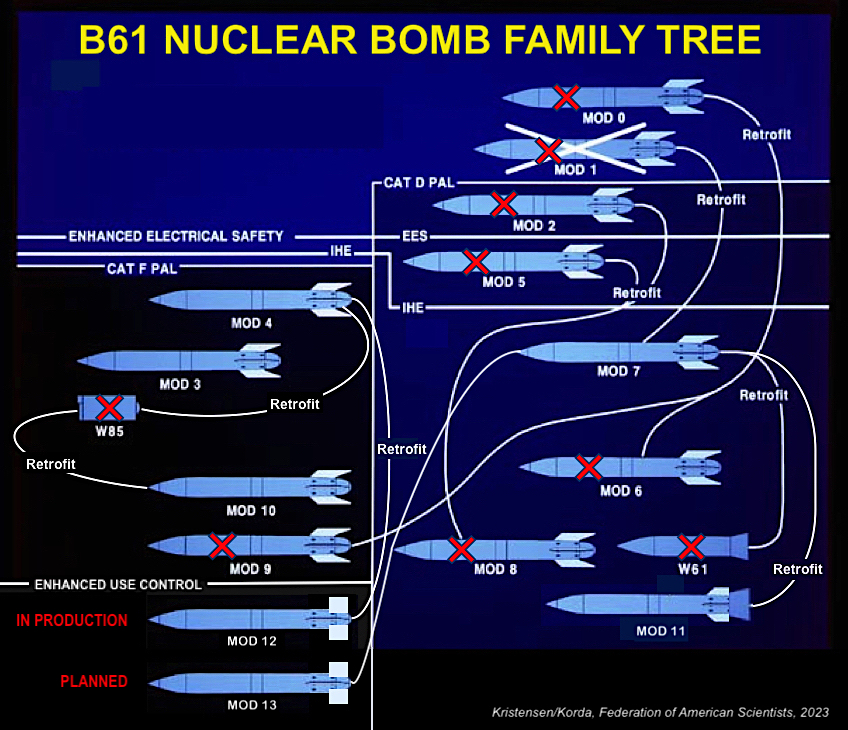
The B61-13 will be the 13th modification of the original B61 bomb. It will use the warhead from the B61-7 but with enhanced use- and security features and a guided tail kit like the B61-12 to increase accuracy.
The B61-13 will have the same maximum yield as the B61-7 (360 kilotons), according to defense officials, a significant increase compared with the 50-kiloton B61-12 it is intended to supplement. If detonated on the surface, a yield of 360 kilotons would cause significant radioactive fallout over large areas.
The effects of a 360-kiloton explosion are significantly greater than those that would result from a 50-kiloton explosion. The following map compared the radioactive fallout from a ground burst detonation in North Korea. Depending on target location and weather conditions, the fallout from a B61-13 could reach half-way across South Korea (simulation from Nukemap).
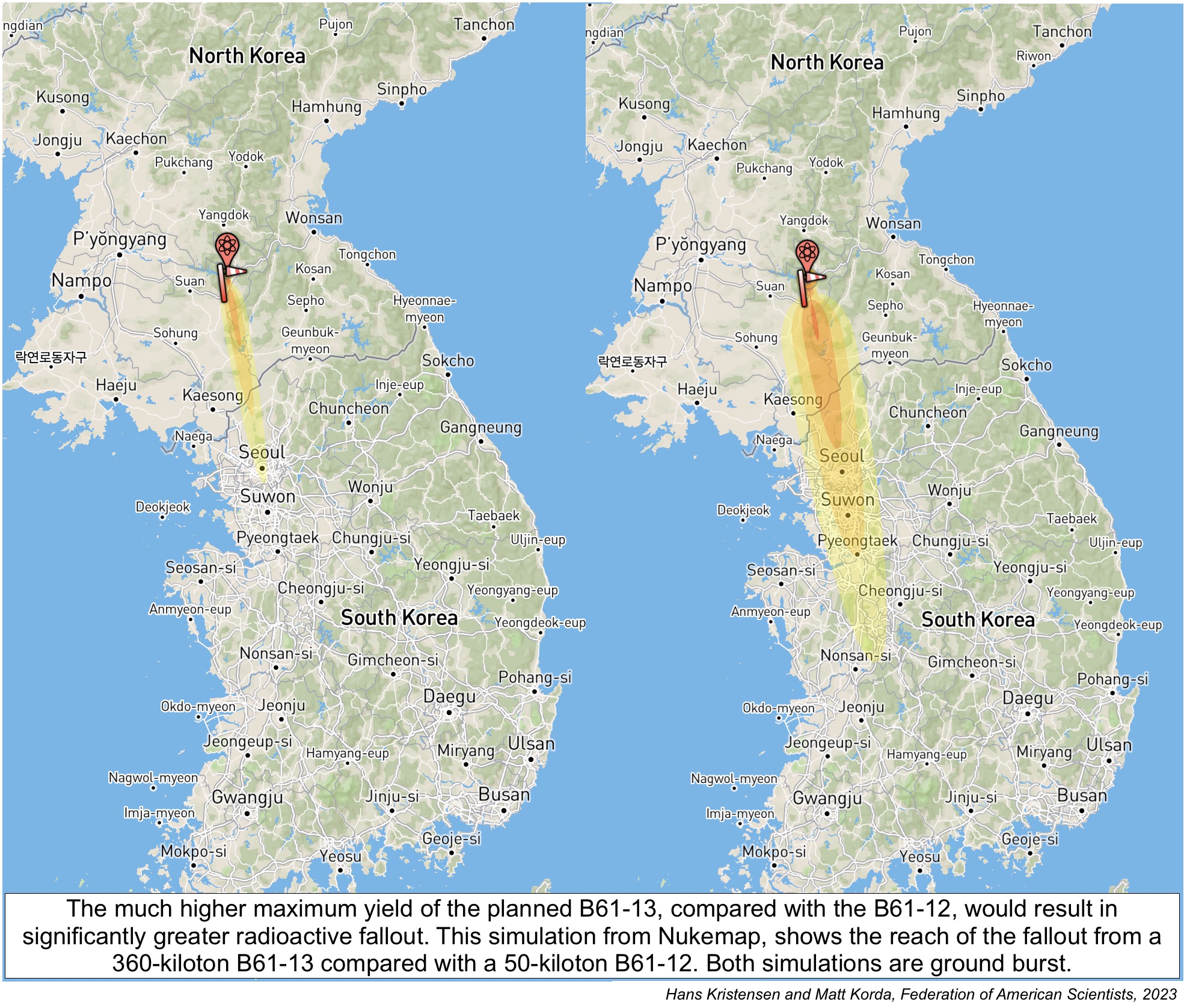
Similar to the B61-12, the B61-13 will likely also have limited earth-penetration capabilities (through soft soil), which will be enhanced by the addition of the guided tail kit. Due to the phenomenon of ground-shock coupling, the B61-13’s relatively high yield and accuracy will likely enable the bomb to strike underground targets with yields equivalent to a surface-burst weapon of more than one megaton. The B61-13 will also have lower-yield options (see table below).
Although government officials insist that the B61-13 plan is not driven by new developments in adversarial countries or a new military targeting requirement, increasing the accuracy of a high-yield bomb obviously has targeting implications. Detonating the weapon closer to the target will increase the probably that the target is destroyed, and a very hard facility could hypothetically be destroyed with one B61-13 instead of two B61-12s. The DOD says the B61-13 will “provides us with additional flexibility” by “providing the President with additional options against certain harder and large-area military targets.”
Once the B61-12 and B61-13 are produced and stockpiled, the older versions replaced, and the B83-1 retired, the changes to the gravity weapons inventory will look something like this:
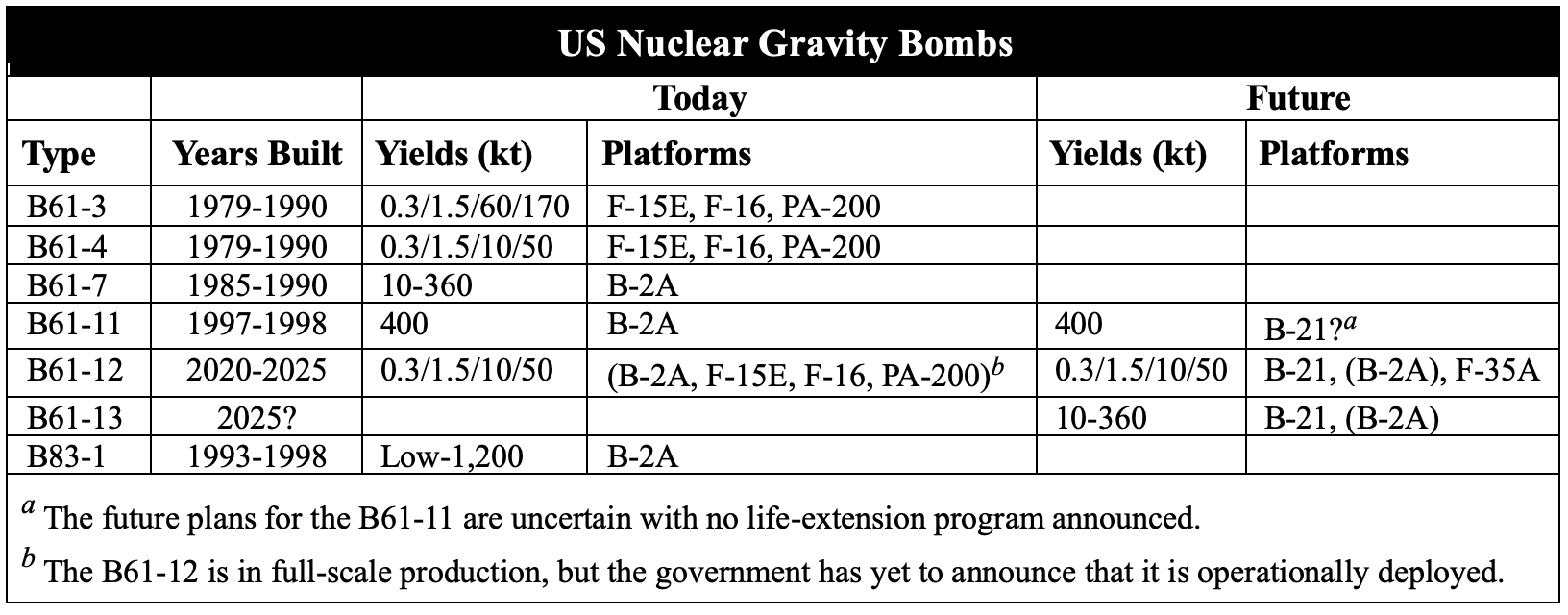
Although the B61-12 was previously said to also allow retirement of the B61-11 earth-penetrator, the B61-13 plan only appears intended to facilitate retirement of the B83-1. There is currently no life-extension program for the B61-11. The plan might be to allow it to age out. Officials say the B61-13 plan does not preclude that the United States potentially decides in the future to field a new nuclear earth-penetrator to replace the B61-11. But there is no decision on this yet.
Defense officials explain that the new B61-13 will not result in an increase of the overall number of warheads in the stockpile. The reason is that the administration plans to reduce the number of B61-12s produced by the number of B61-13s produced, so the total number of new bombs will ultimately be the same. The production plan for the B61-12 involved an estimated 480 bombs for both strategic bombers and dual-capable fighters. Since the bombers will now carry both B61-12 and B61-13 bombs (in addition to the new LRSO cruise missiles), and because the actual number of targets requiring a high-yield gravity bomb is probably small, it seems likely that the number of B61-13 bombs to be produced is very limited – perhaps on the order of 50 weapons – and that production will happen at the back end of the B61-12 schedule in 2025.
Unlike the B61-12s – of which a portion will be forward-deployed to Europe for use with NATO’s dual-capable aircraft – all of the B61-13s will be stored within the United States for use with the incoming B-21 bomber and the B-2 bomber (until it is replaced by the B-21). Nonetheless, because the B61-13 will use the same mechanical and electronic interface as the B61-12, the fighters that are destined to deliver the B61-12 will also be capable of delivering the B61-13. But the current plan is that the B61-13 is only for the bombers.
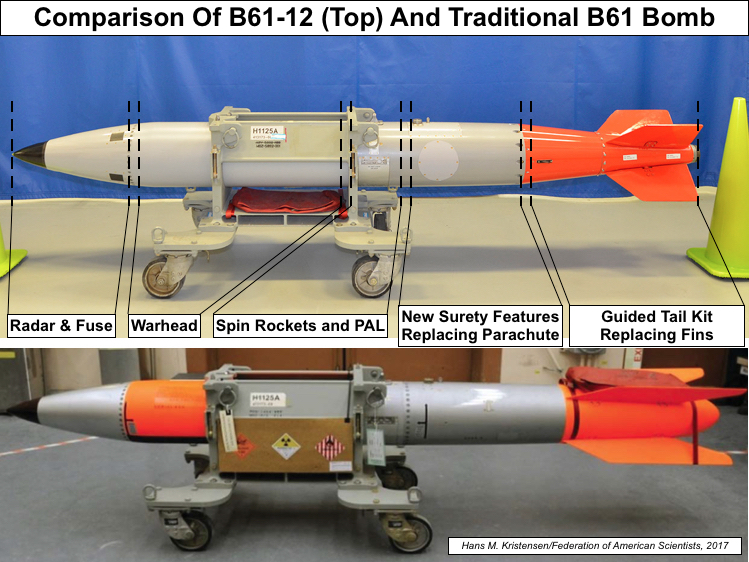
The B61-13 will look identical to the B61-12 (top) but use a much more powerful warhead from the B61-7. It is intended for delivery by bombers but can technically also be delivered by fighter jets (although that is not planned).
A Political Nuclear Bomb
The military justification for adding the B61-13 to the stockpile is hard to see. Instead, it seems more likely to be a political maneuver to finally get rid of the B83-1.
Defense officials say that the decision is not related to current events or developments in China, Russia, or other potential adversaries. Nor is the administration’s decision a product of the hard and deeply buried target capability study mentioned in the 2022 Nuclear Posture Review.
The B61-13 is a separate decision, they explain.
The military doesn’t need an additional, more powerful gravity bomb. In fact, Air Force officials privately say the military mission of nuclear gravity bombs is decreasing in importance because of the risk of putting bombers and their pilots in harm’s way over heavily defended targets – particularly as long-range missiles are becoming more capable.
To that end, the military mission of the B61-13 is somewhat of a mystery, especially given that the LRSO will also be arming the bombers and that the United States has thousands of other high-yield weapons in its arsenal.
Instead, what appears to have happened is this: after defense hardliners blocked the administration’s plans to retire the B83-1, the administration likely agreed to retain the B61-7 yield in the stockpile in the form of a modern bomb modification (B61-13) that is easier and cheaper to maintain, so that they can finally proceed with the retirement of the B83-1.
As such, the B61-13 will be the second “political” weapon in recent memory. The first was the low-yield W76-2 warhead fielded in late-2019 on the Trident submarines. The next one could be a nuclear sea-launched cruise missile (SLCM-N), if defense hawks have their way.
Additional Information
• US nuclear weapons, 2023
• The B61 Family of Nuclear Bombs
This research was carried out with generous contributions from the New-Land Foundation, Ploughshares Fund, the Prospect Hill Foundation, Longview Philanthropy, and individual donors.
If Arms Control Collapses, US and Russian Strategic Nuclear Arsenals Could Double In Size
On January 31st, the State Department issued its annual Report to Congress on the Implementation of the New START Treaty, with a notable––yet unsurprising––conclusion:
“Based on the information available as of December 31, 2022, the United States cannot certify the Russian Federation to be in compliance with the terms of the New START Treaty.”
This finding was not unexpected. In August 2022, in response to a US treaty notification expressing an intent to conduct an inspection, Russia invoked an infrequently used treaty clause “temporarily exempting” all of its facilities from inspection. At the time, Russia attempted to justify its actions by citing “incomplete” work regarding Covid-19 inspection protocols and perceived “unilateral advantages” created by US sanctions; however, the State Department’s report assesses that this is “false:”
“Contrary to Russia’s claim that Russian inspectors cannot travel to the United States to conduct inspections, Russian inspectors can in fact travel to the United States via commercial flights or authorized inspection airplanes. There are no impediments arising from U.S. sanctions that would prevent Russia’s full exercise of its inspection rights under the Treaty. The United States has been extremely clear with the Russian Federation on this point.”
Instead, the report suggests that the primary reason for suspending inspections “centered on Russian grievances regarding U.S. and other countries’ measures imposed on Russia in response to its unprovoked, full-scale invasion of Ukraine.”
Echoing the findings of the report, on February 1st, Cara Abercrombie, deputy assistant to the president and coordinator for defense policy and arms control for the White House National Security Council, stated in a briefing at the Arms Control Association that the United States had done everything in its power to remove pandemic- and sanctions-related limitations for Russian inspectors, and that “[t]here are absolutely no barriers, as far as we’re concerned, to facilitating Russian inspections.”
Nonetheless, Russia has still not rescinded its exemption and also indefinitely postponed a scheduled meeting of the Bilateral Consultative Commission in November. In a similar vein, this is believed to be tied to US support for Ukraine, as indicated by Deputy Foreign Minister Sergei Ryabkov who said that arms control “has been held hostage by the U.S. line of inflicting strategic defeat on Russia,” and that Russia was “ready for such a scenario” if New START expired without a replacement.
These two actions, according to the United States, constitute a state of “noncompliance” with specific clauses of New START. It is crucial to note, however, the distinction between findings of “noncompliance” (serious, yet informal assessments, often with a clear path to reestablishing compliance), “violation” (requiring a formal determination), and “material breach” (where a violation rises to the level of contravening the object or purpose of the treaty).
It is also important to note that the United States’ findings of Russian noncompliance are not related to the actual number of deployed Russian warheads and launchers. While the report notes that the lack of inspections means that “the United States has less confidence in the accuracy of Russia’s declarations,” the report is careful to note that “While this is a serious concern, it is not a determination of noncompliance.” The report also assesses that “Russia was likely under the New START warhead limit at the end of 2022” and that Russia’s noncompliance does not threaten the national security interests of the United States.
The high stakes of failure: worst-case force projections after New START’s expiry
Both the US and Russia have meticulously planned their respective nuclear modernization programs based on the assumption that neither country will exceed the force levels currently dictated by New START. Without a deal after 2026, that assumption immediately disappears; both sides would likely default to mutual distrust amid fewer verifiable data points, and our discourse would be dominated by worst case thinking about how both countries’ arsenals would grow in the future.
For an example of this kind of thinking, look no further than the new Chair of the House Armed Services Committee, who argued in response to the State Department’s findings of Russian noncompliance that “The Joint Staff needs to assume Russia has or will be breaching New START caps.” As previously mentioned, the State Department report explicitly states that they have only found Russia to be noncompliant on facilitating inspections and BCC meetings, not on deployed warheads and launchers.
It is clear that the longer that these compliance issues persist, the more they will ultimately hinder US-Russia negotiations over a follow-on treaty, which is necessary in order to continue the bilateral strategic arms control regime beyond New START’s expiry in February 2026. As Amb. Steve Pifer, non-resident Senior Fellow at the Brookings Institution, noted during the ACA webinar, “We have three years until New START expires. That seems like a lot of time, but it’s not a long of time if you’re going to try to do something ambitious.”
To that end, both sides should be clear-eyed about the stakes, and more specifically, about what happens if they fail to secure a new deal limiting strategic offensive arms.
The United States has a significant upload capacity on its strategic nuclear forces, where it can bring extra warheads out of storage and add them to the deployed missiles and bombers. Although all 400 deployed US ICBMs currently only carry a single warhead, about half of them use the Mk21A reentry vehicle that is capable of carrying up to three warheads each. Moreover, the United States has an additional 50 “warm” ICBM silos which could be reloaded with missiles if necessary. With these potential additions in mind, the US ICBM force could potentially more than double from 400 to 950 warheads.
In the absence of treaty limitations, the United States could also upload each of its deployed Trident SLBMs with a full complement of eight warheads, rather than the current average of four to five. Factoring in the small numbers of submarines that are assumed to be out for maintenance at any given time, then the United States could approximately double the number of warheads deployed on its SLBMs, to roughly 1,920. The United States could potentially also reactivate the four launch tubes on each submarine that it deactivated to meet the New START limit, thus adding 56 missiles with 448 warheads to the fleet. However, this possibility is not reflected in the table because it is unlikely that the United States would choose to reconstitute the additional four launch tubes on each submarine given their imminent replacement with the next-generation Columbia-class.
Either of these actions would likely take months to complete, particularly given the complexities involved with uploading additional warheads on ICBMs. Moreover, ballistic missile submarines would have to return to port on a rotating schedule in order to be uploaded with additional warheads. However, deploying additional warheads to US bomber bases could be done very quickly, and the United States could potentially upload nearly 700 cruise missiles and bombs on its B-52 and B-2 bombers.
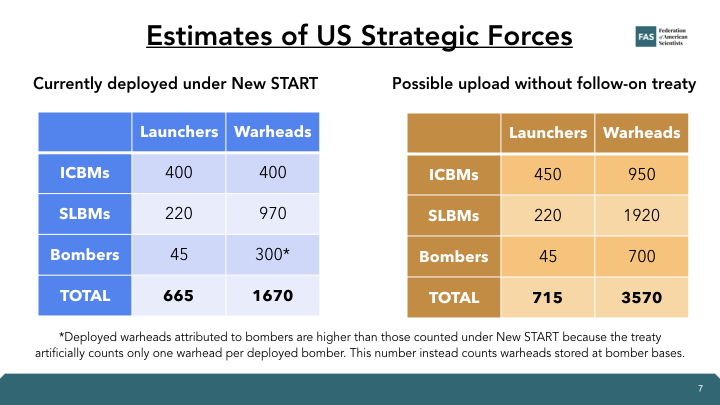
[Note: These numbers are projections based off of estimates; they are not predictions or endorsements. They also do not take into account how the number of available launchers and warheads will change when ongoing modernization programs are eventually completed, as this is unlikely to occur before New START’s expiry in 2026]
Russia also has a significant upload capacity, especially for its ICBMs. Several of Russia’s existing ICBMs are thought to have been downloaded to a smaller number of warheads than their maximum capacities, in order to meet the New START force limits. As a result, without the limits imposed by New START, Russia’s ICBM force could potentially increase from approximately 834 warheads to roughly 1,197 warheads.
Warheads on submarine-launched ballistic missiles onboard some of Russia’s SSBNs are also thought to have been reduced to a lower number to meet New START limits. Without these limitations, the number of deployed warheads could potentially be increased from an estimated 640 to approximately 832 (also with a small number of SSBNs assumed to be out for maintenance). As in the US case, Russian bombers could be loaded relatively quickly with hundreds of nuclear weapons. The number is highly uncertain but assuming approximately 50 bombers are operational, the number of warheads could potentially be increased to nearly 600.
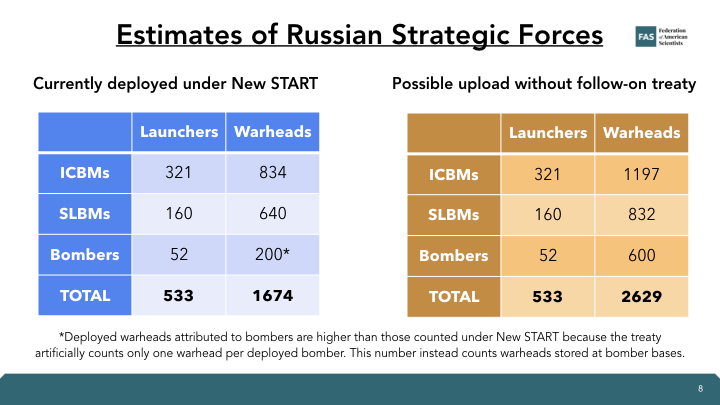
Slide showing estimates of Russian strategic forces, as well as a projection showing the possible upload without a follow-on treaty. Numbers mirror those found in the article text.
Combined, if both countries uploaded their delivery systems to accommodate the maximum number of possible warheads, both sets of arsenals would approximately double in size. The United States would have more deployable strategic warheads but Russia would still have a larger total arsenal of operational nuclear weapons, given its sizable stockpile of nonstrategic nuclear warheads which are not treaty-accountable.
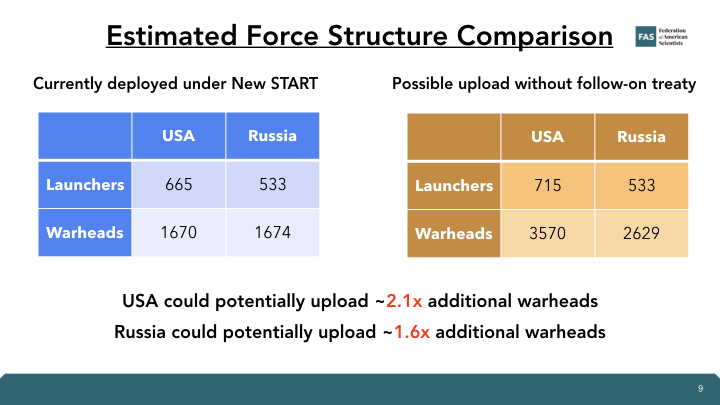
Slide showing comparison estimates of US and Russian strategic forces, as well as a projection showing the possible upload without a follow-on treaty. Numbers mirror those found in the article text.
Moreover, there are expected consequences beyond the offensive strategic nuclear forces that New START regulates. If the verification regime and data exchanges elapse, both countries are likely to enhance their intelligence capabilities to make up for the uncertainty regarding the other side’s nuclear forces. Both countries are also likely to invest more into what they perceive will increase their overall military capabilities, such as conventional missile forces, nonstrategic nuclear forces, and missile defense.
These moves could trigger reactions in other nuclear-armed states, some of whom might also decide to increase their nuclear forces and the role they play in their military strategies. In particular, it is becoming increasingly clear that China appears to no longer be satisfied with just a couple hundred nuclear weapons to ensure its security, and in a shift from longstanding doctrine, may now be looking to size its own nuclear force closer to the size of the US and Russian deployed nuclear forces.
Some US former defense officials have suggested that the United States needs to increase its deployed nuclear force to compensate for the increased nuclear arsenal that China is already building and an alleged increase in Russian non-strategic nuclear weapons––either by negotiating a higher treaty limit with Russia or withdrawing from the New START treaty.
But doing so would not solve the problem and could put the United States on a path where it would in fact face even greater numbers of Russian and Chinese nuclear weapons in the future. A higher treaty warhead limit would obviously increase – not reduce – the number of Russian warheads aimed at the United States; and pulling out of New START would likely cause Russia to deploy even more weapons. Moreover, a significant increase in the size of US and Russian deployed nuclear forces could cause China to increase its arsenal even further. Such developments could subsequently have ripple effects for India, Pakistan, and elsewhere – developments that would undermine, rather than improve, US and international security.
Uploading more warheads is not necessary to maintain deterrence
It is important to note that even if such worst-case scenarios were to occur, in the past the Department of Defense and the Director of National Intelligence have assessed that even a significant Russian increase of deployed nuclear warheads would not have a deleterious effect on US deterrence capabilities. A 2012 joint study assessed:
“[E]ven if significantly above the New START Treaty limits, [Russia’s deployment of additional nuclear warheads] would have little to no effect on the U.S. assured second-strike capabilities that underwrite our strategic deterrence posture. The Russian Federation, therefore, would not be able to achieve a militarily significant advantage by any plausible expansion of its strategic nuclear forces, even in a cheating or breakout scenario under the New START Treaty, primarily because of the inherent survivability of the planned U.S. strategic force structure, particularly the OHIO-class ballistic missile submarines, a number of which are at sea at any given time.”
Although the political situation has dramatically changed over the past decade since the study was published, this particular deterrence dynamic has not. The United States’ second-strike capabilities remain as secure today––even among Russia’s noncompliance and China’s nuclear buildup––as they did a decade ago. As a result, it seems clear that although uploading additional warheads onto US systems may seem like a politically strong response, it would not offer the United States any additional advantage that it does not already possess, and would likely trigger developments that would not be in its national security interest.
—
Background Information:
- “The Long View: Strategic Arms Control After the New START Treaty,” FAS Nuclear Notebook, Bulletin of the Atomic Scientists, November 2022.
- “United States nuclear weapons, 2023,” FAS Nuclear Notebook, Bulletin of the Atomic Scientists, January 2023.
- “Russian nuclear weapons, 2022,” FAS Nuclear Notebook, Bulletin of the Atomic Scientists, February 2022.
- Status of World Nuclear Forces, Federation of American Scientists
This research was carried out with generous contributions from the John D. and Catherine T. MacArthur Foundation, the New-Land Foundation, Ploughshares Fund, the Prospect Hill Foundation, Longview Philanthropy, the Stewart R. Mott Foundation, the Future of Life Institute, Open Philanthropy, and individual donors.
Remembering Hiroshima and Nagasaki, 75 Years After
Seventy-five years ago, the United States conducted two nuclear attacks against the cities of Hiroshima and Nagasaki, Japan, devastating their populations and destroying their infrastructure.
In the process of manufacturing and testing the nuclear weapons that would eventually be used on Hiroshima and Nagasaki, civilians within downwind communities, nuclear workers, uranium miners and their families, and military personnel were also exposed to harmful and sometimes deadly levels of ionizing radiation. Following their use in Japan, the production and past testing of nuclear weapons in the United States and internationally continues to harm the health, environment, and cultures of communities around the world.
In the United States, we are commonly told that creating and dropping these nuclear bombs was “necessary” in order to end the Second World War and save additional lives. As several prominent historians have detailed extensively, this narrative is oversimplistic and ahistorical: the bombs were never intended to take the place of an invasion, and it is not even clear that they directly brought about the end of the war in the way that is often portrayed. Primary documents show that the commonly-taught narrative about the two atomic bombings can be easily deconstructed. Additionally, these nuclear bombings followed devastating conventional firebombings of Japanese cities that were specifically designed to target civilians and infrastructure.
Seventy-five years later, we commemorate the nuclear attacks and the unspeakable human suffering they inflicted, which remind us of the uniquely destructive capability of nuclear weapons and the importance of ensuring that they are never used in anger again.
In recognition of this 75th anniversary, the Federation of American Scientists is honored to join a coalition of nuclear weapons organizations and survivors in calling for our leaders to take the actions necessary to ensure nuclear weapons are never used again and to negotiate in good faith the global elimination of these most devastating weapons of mass destruction.
As our coalition statement reads,
Today, we are living in a time of extraordinary nuclear dangers. Vital international agreements to reduce and control nuclear weapons worldwide are being abandoned. Budgets for the development and production of new nuclear weapons are growing. Tensions among nuclear-armed nations are rising to levels not seen since the Cold War.
As the mayors of Hiroshima and Nagasaki warn: “We are badly off course in efforts to honor the plea of the hibakusha and end the nuclear threat.”
As the only country to use nuclear weapons in conflict, the United States has a moral obligation to lead the world in ending this menace and restoring communities impacted by nuclear weapons.
People created these weapons and designed the systems governing their use; people can work to eliminate them.
As we wrote on the 75th anniversary of the Trinity test, we are trending in the wrong direction. Despite reductions since the Cold War, there are still more than 13,000 nuclear weapons in the world, and every nuclear-armed country is currently in the midst of modernizing their nuclear arsenals. Disturbingly, bilateral and multilateral arms control agreements have fallen away or are currently under severe stress. Most immediately concerning is New START, which effectively limits US and Russian strategic warhead and launcher deployments, but expires in February 2021. As we have written, New START extension is a no-brainer: Russia and the United States can extend the New START treaty by up to 5 more years. It is essential both sides act responsibly and do so to preserve this essential agreement.
The Federation of American Scientists is honored to provide the world with the best non-classified estimates of the nuclear weapons arsenals. We are grateful for the financial support from the New Land Foundation, MacArthur Foundation, Ploughshares Fund, and the Prospect Hill Foundation to do this work. To explore this vast data, developed over many decades, start here.
75 Years Ago: The Trinity Nuclear Test
On this day 75 years ago, the world entered the nuclear age. The first ever nuclear detonation – known as the Trinity test – took place in New Mexico on July 16th, 1945. Since then, ten countries built more than 134,000 nuclear weapons. More than 13,400 remain today.
In the decades that followed, nuclear testing contaminated lands, oceans, and people, and triggered a nuclear arms race that continues to this day. The Federation of American Scientists is honored to join our colleagues at the Union of Concerned Scientists and Tularosa Basin Downwinders Consortium in a joint statement with five other U.S. organizations on the humanitarian consequences of nuclear testing, endured by victims in the United States and its Pacific territories, from French nuclear testing in French Polynesia and Algeria, Russian nuclear testing in Kazakhstan, British nuclear testing in Australia, and others.
In addition to these harms, the Trinity test marked the beginning of the global nuclear arms race with its endless cycles of nuclear modernization and competition, which continue to this day. Unlike any other invention, nuclear weapons have the capability to destroy human civilization and much or life on Planet Earth.
The Federation of American Scientists has tracked the rise and fall of global nuclear arsenals for many years. Despite reductions since the Cold War, there are still more than 13,000 nuclear weapons in the world. And we are disappointed to note the emergence of five disturbing trends regarding the current and future state of nuclear weapons:
- Every nuclear-armed country is currently in the midst of modernizing their nuclear arsenals. Some countries are actually increasing their stockpiles, while others are swapping out their older weapons with newer, more effective ones that will endure almost until the end of the 21st century.
- Not only are nuclear arsenals either increasing or improving, but it appears that many states are reinvigorating or even expanding the role of nuclear weapons – specifically tactical nuclear weapons – in their military doctrines. State representatives have often claimed that these deployments are actually intended to prevent conflict; however, regardless of how much stake one puts into that sort of statement, it is a fact that many states are now increasingly posturing themselves for nuclear warfighting. This development will make it more difficult to reduce the role of nuclear weapons and pursue significant reductions – and certainly disarmament – in the future.
- In recent years, we have also seen the decline – and general disinterest – in arms control writ large. Today, bilateral and multilateral arms control agreements have fallen away or are under severe stress, multilateral efforts to engage in good faith arms reductions appear to have completely stagnated, and states often seem more interested in blaming and shaming their prospective arms control partners than actually pursuing measures that would offer a modicum of transparency and predictability in an otherwise unpredictable world.
- Rather than pursue arms control, it seems that states are more content with pursuing arms competition and even arms races. This is a result of renewed military competition and is fueled by the tremendous influence that weapons contractors and lobbyists have on government decisions; indeed, sometimes nuclear decisions seem to be driven as much – if not more – by corporate interests than by national security concerns.
- Nuclear-armed states largely do not appear to consider nuclear disarmament to be an urgent global security, humanitarian, or environmental imperative. Instead, most states seem to consider disarmament as a type of chore mandated by the Non-Proliferation Treaty – and not one that they are seriously interested in completing in the foreseeable future. It is increasingly rare to hear any officials from nuclear weapon states express a coherent rationale for pursuing disarmament other than as a result of the obligation to do so under the Non-Proliferation Treaty. Moreover, they seem increasingly focused on shifting the disarmament responsibility onto the non-nuclear states by arguing they first must create the security conditions that will make nuclear disarmament possible.
Although the Trinity test took place 75 years ago, its destructive legacy continues to this day. And despite these harms, some politicians are even trying to return to an era of live nuclear testing. Resuming nuclear explosive testing would be taking a monumental step backward and would open the floodgates for worldwide resumption of nuclear testing and development of new nuclear weapons. Instead, on this 75th anniversary, we must look forward, try our best to reverse these worrying trends, responsibly reduce the arsenals and the role that nuclear weapons serve, and work towards a world eventually free from nuclear weapons.
The Federation of American Scientists is honored to provide the world with the best non-classified estimates of the nuclear weapons arsenals. We are grateful for the financial support from the New Land Foundation, MacArthur Foundation, Ploughshares Fund, and the Prospect Hill Foundation to do this work. To explore this vast data, developed over many decades, start here: https://fas.org/issues/nuclear-weapons/status-world-nuclear-forces/
The State Department’s Compliance Report Plays the Blame Game, Despite Offering Little Evidence
The State Department’s Bureau of Arms Control, Verification and Compliance yesterday released its annual “Compliance Report,” which provides a detailed overview of US (and other countries’) adherence to various treaty and agreement commitments.
The report’s publication comes at a critical time, as the Trump administration has spent the past few years––and the past three months in particular––dismantling the last vestiges of US commitments to the international arms control regime. The administration has recently declared that it is unlikely to extend New START, has withdrawn from the Open Skies Treaty, has alluded to an intent to resume nuclear testing, and has announced that it will “reinterpret” the Missile Technology Control Regime in order to allow the United States to sell armed drones to previously-forbidden countries.
In addition to its intended purpose––providing the official public US assessment of how other countries adhere to arms control treaties and agreements––the administration clearly sees the Compliance Report as a tool to provide justification for shedding treaties. As such, other countries might question the report’s conclusion that the United States is in full compliance with all of its international obligations, but that other treaty parties are not.
Several sections of the Compliance Report are missing both critical context about how and why certain treaties met their eventual ends, as well as actual evidence for some of its claims about the actions of its arms control partners. To that end, we have tried to fill in some of the blanks below.
The Intermediate-Range Nuclear Forces (INF) Treaty
The report assesses that throughout 2019, the United States was in full compliance with the INF Treaty––the landmark Cold War-era treaty that eliminated and banned all US and Russian ground-launched missiles with ranges between 500 and 5,500 kilometers.
Although this assertion appears to be technically correct and provides an extensive overview of Russian activities, it is missing some critical context. Both the United States and Russia suspended their respective obligations under the treaty in February 2019, and the treaty officially died in August 2019. Although it appeared that Russia had been violating the treaty for many years, we have argued that the Trump administration’s decision to finally kill the treaty was the wrong move, for several reasons.
Firstly, withdrawal established a false moral equivalency between the United States, who probably was not violating the treaty, and Russia, who probably was. It also put the United States in conflict with its own key policy documents like the Nuclear Posture Review and public statements made last year, which emphasized staying in the treaty while trying to bring Russia back into compliance through diplomatic, economic, and military measures. NATO preferred this approach until the Trump administration changed its mind and decided to withdraw, at which point NATO followed suit to avoid being seen to be in conflict with Washington.
The 2020 Compliance Report states that withdrawal from the INF Treaty was intended as a “remedy” for Russia’s material breach. But if the ultimate goal was to coax or coerce Russia back into compliance, then killing the treaty did the opposite. Instead, it legally freed Russia to deploy even more INF missiles on land, something the report explicitly warns that Russia might do by converting the SS-N-30a/Sagaris (Kalibr) sea-launched cruise missile into a land-based system. It also allowed the United States to explore developing INF-range missiles of its own. Only 16 days after the treaty’s collapse, the United States test launched a crudely-fashioned missile that would have certainly violated the INF treaty––if it had still existed.
New START
The 2020 Compliance Report notes that both Russia and the United States are in full compliance with the New START treaty, which caps the number of strategic nuclear warheads and delivery vehicles that each country is allowed to deploy. This is not newsworthy in itself; mutual compliance was confirmed by State and Defense Department officials during Senate testimony in 2018, after the February treaty deadline had passed.
It is bizarre that the Trump administration is using alleged Russian non-compliance with other treaties in order to undermine the one treaty with which Russia is actually complying. Moreover, unlike any other treaty mentioned in the Compliance Report, the strategic forces limited by the New START treaty are the only weapons of mass destruction that can threaten the very existence of the United States.
New START expires in less than a year, and while Russia has agreed to extend it unconditionally, the Trump administration has been dragging its feet. This should be a no-brainer: the treaty is a good deal for both parties, it offers a critical source of predictability and transparency into Russia’s nuclear forces, and extension is widely supported across the country, even among Trump voters; in fact, it’s one of the very few bipartisan issues still remaining in Congress. Senior military leaders, such as the Vice Chairman of the Joint Chiefs of Staff and the commander of Air Force Global Strike Command, have declared their full support for the treaty, largely because it offers a critical source of transparency and stability in the US-Russia nuclear relationship.
Specifically, during the 2018 Senate hearing, then-Under Secretary of State for Arms Control and International Security Affairs noted “The United States benefits from the Treaty’s 18 annual on-site inspections, notifications, and biannual data exchanges, which give us insight into the number of Russia’s strategic offensive arms subject to the Treaty and where they are at any given time.” She further noted, “Should the Treaty expire, U.S. inspectors would lose their current access to Russian strategic nuclear warheads and delivery systems, bases, and infrastructure, as well as the Treaty’s biannual exchange of data and associated updates on the location and status of Russia’s strategic offensive arms subject to the Treaty.” However, this fact hasn’t stopped Trump’s new arms control envoy Marshall Billingslea––an ardent opponent of arms control who opposed US ratification of the 1993 Chemical Weapons Convention and the 1996 Comprehensive Test Ban Treaty, and supported US withdrawal in 2002 from the 1972 Anti-Ballistic Missile Treaty––from inexplicably arguing the opposite point. In an interview with The Washington Times last month, he claimed that “The Obama administration negotiated a very weak verification regime […] which the Russians have been exploiting.” The basis for this claim has not been substantiated by other senior administration or military officials, and is not presented in the Compliance Report itself.
In his recent interview, Billingslea noted that a new or extended New START-style deal would necessarily have to include China. This makes no sense. The entire Chinese arsenal is thought to include about 320 warheads––a fraction of the 4,000-4,500 in the US and Russian arsenals––which is why China’s position has consistently been the same: it will not take part in trilateral arms control negotiations while this strategic imbalance remains.
Therefore, as we have previously argued in Forbes, killing New START because it doesn’t include China would do nothing to address the United States’ security concerns about Chinese nuclear forces. Instead, if limits on US and Russian strategic nuclear forces fell away and caused both countries to increase their nuclear forces, China might decide that it would need to increase its stockpile even further in order to adjust to the greater nuclear threat. This would further exacerbate a post-New START nuclear crisis.
Extension does not require Congressional approval; it simply requires a presidential stroke of a pen. Given that both countries benefit from the treaty, that both countries are in compliance, and that the United States’ NATO allies strongly favor an extension, this is a ripe piece of low-hanging fruit.
The Joint Comprehensive Plan of Action
The JCPOA (commonly known as the Iran Nuclear Deal), is not mentioned at all in the Compliance Report. This is not necessarily surprising, as the Trump administration officially withdrew from––and then violated––the deal in 2018. However, in recent weeks, Secretary of State Mike Pompeo has argued that the United States remains a party to the deal, and therefore could demand a reimposition of sanctions on Iran if an arms embargo is not extended past October. As Senator Elizabeth Warren correctly tweeted in response, “This makes no sense.” “To extend this arms embargo,” she noted, “the Trump admin is suddenly arguing that the US is a party to the same Iran Deal it abandoned.”
Pompeo’s unconvincing argument is undermined by his own former State Department top arms control official, who noted in her 2018 Senate testimony that the United States completed its “withdrawal from the arrangement on May 8.” Additionally, if the Secretary of State truly believed that the United States was still party to the treaty, why would it be excluded from his own department’s comprehensive annual assessment of US treaty obligations?
The absence of JCPOA is even more curious because Iran’s nuclear activities are covered extensively over seven full pages in the Compliance Report.
Nuclear Testing
The Compliance Report does not assess any country’s compliance with the Comprehensive Test Ban Treaty (CTBT) because the United States has not ratified it. The report repeats the Trump administration’s statement that it has no intentions to ratify the treaty, but nonetheless assesses that Russia and China may have conducted nuclear weapons tests that fail to meet the United States’ “zero-yield” standard. This assertion echoes the claims initially made by DIA Director Ashley during his remarks at the Hudson Institute in May 2019.
On Russia, the report states that the “United States assesses that Russia has conducted nuclear weapons-related experiments that have created nuclear yield.” But it adds in the next sentence that the “United States does not know how many, if any [emphasis added], supercritical or self-sustaining nuclear experiments Russia conducted in 2019.” A test that released nuclear energy from a canister would require Russian notification under the Threshold Test Ban Treaty (TTPT), which Russia has not provided. But the Compliance Report does not present any evidence but says additional information is included in a classified annex.
On China, the report is even more vague and circumstantial. It doesn’t explicitly accuse China of having conducted low-yield nuclear tests nor present evidence to that effect. Instead, the Compliance Report says a number of other activities “raise concern” about China’s adherence to the zero-yield standard of the United States and that “the United States cannot rule out the possibility that China could have conducted activities at its test site that are inconsistent with its moratorium commitment…” Details are hidden in a classified annex.
Open source analysists have not detected “any alarming activity” in this regard. Absent public evidence, both China and Russia have rejected the claims, with the Russian Deputy Foreign Minister “[urging] the United States to abandon the growing practice of misinforming the global community about what is happening,” and the Chinese Foreign Ministry spokesperson “[refusing] to dignify the groundless US allegation with a refutation.”
Claims about Chinese and Russian low-yield testing are not new, but are occasionally used by anti-arms control hawks working to hype the Russian or Chinese threat, in addition to pushing for the United States to resume nuclear weapons testing. It is unfortunate that this year’s Compliance Report echoed these claims without offering any public proof to back them up, and that would-be arms control killers are subsequently using them as “evidence” of cheating.
Presidential Nuclear Initiatives
A new addition to this year’s Compliance Report is a large section (three and a half pages) on the 1991-1992 Presidential Nuclear Initiatives (PNIs). This is an oddball because the PNIs were unilateral declaration, not treaties, without any verification. Apparently, including the PNIs is part of the administration effort to make the case that Russia is cheating and therefore can’t be trusted with other treaties such as the New START treaty.
Russia is cheating on one part of the PNIs, the report says, because Russia hasn’t eliminated all nuclear warheads for Ground Forces as it promised in 1991. The report explicitly identifies the SS-21 and SS-26 short-range ballistic missiles (the SS-26 is replacing the SS-21) as dual-capable. The report does not explicitly say Russian ground-forces have retained nuclear artillery, a frequent rumor on the Internet. Curiously, the SSC-8 GLCM is not mentioned in the PNI section, even though it is a ground-launched dual-capable weapon (it is addressed in the INF section of the report).
The big picture, of course, is that Russia has fulfilled most of the PNI promises and significantly reduced its inventory of non-strategic nuclear weapons since the 1990s. The Compliance Report only mentions in passing that “Russia continues to abide by some PNI pledges, such as warhead consolidation and likely the declared reduction in stockpiles…” Although Russia retains more non-strategic nuclear weapons than the United States (up to 2,000 according to the Nuclear Posture Review), that has been the case for the past three decades. Statements by US government officials indicate that Russia reduced its inventory of non-strategic nuclear weapons between 2009 and 2019 by more than one-third.
One thing completely missing from the Compliance Report’s assessment of the PNI issue is that US planned production of a new nuclear sea-launched cruise missile––as recommended by the Nuclear Posture Review––would be in violation of the United States’ own PNI pledge.
The Role of the Compliance Report
Violations of treaties and agreements must be addressed and resolved, which requires a persistent and professional level of engagement with other countries. Because the Trump administration is focused on abandoning treaties and reinvigorating “Great Power Competition” with Russia and China, however, the Compliance Report may increasingly be seen as a means to provide a justification for that agenda.
Even if Russia is cheating on some agreements, that doesn’t mean they will cheat on all of them, or that it is no longer worth it to retain the ones that are working. Russia has a clear interest in limiting US nuclear forces just as the United States and its allies have an interest in limiting Russian forces.
And even though China is slowly increasing its nuclear arsenal, that doesn’t mean that it is necessarily sprinting to parity. Even if the DIA’s projection that China will “at least double the size of its nuclear stockpile” over the next decade were to happen, that would still not bring the inventory anywhere near the size of the US or Russian stockpiles, which are currently estimated at 4,310 and 3,800 warheads, respectively.
There is also an expectation that if China increases its arsenal it will inevitably result in the abandonment of its no-first-use policy. In February, the head of US STRATCOM offered Senate testimony that he “could drive a truck through that no-first-use policy.” But others, such as Gregory Kulacki, have noted that China’s nuclear strategy is more restrained than what the public debate often assumes.
In sum, the annual Compliance Report should function as a way for the United States and its arms control partners to get on the same page about the status of their respective obligations and anticipate where future compliance issues might arise––not as a way to offer justifications for its own misdeeds. Otherwise, its publication may soon contribute to a breakdown in arms control altogether, rather than function as a mechanism to save it.
A Rare Look Inside a Russian ICBM Base
It’s relatively easy to observe Russian missile bases from above. It’s much harder to do it from inside.
But in September, the Russian Ministry of Defense released a rare video of a command exercise which features mobile SS-27 Mod 2 “Yars-S” ICBMs driving around their base near Novosibirsk.
The base itself, which is likely to be the temporary home of the 382nd Guards Missile Regiment, has a relatively strange layout, which makes it significantly easier to identify. Unlike other Yars bases in the 39th Guards Missile Division (which houses the 382nd Regiment)––or even across the region––this base does not have any vehicle garages. Instead, the Yars launchers and support vehicles are simply parked out in the open, usually under camouflage (although they occasionally mix up their camouflage, weirdly replacing the forest green with snowy white well before any snow actually touches the ground!).
The September video shows Russian troops uncovering their ICBMs, taking them out for a spin, and eventually tucking them back in under camouflage blankets.
This regiment––along with the other two Novosibirsk bases associated with the 39th Guards Missile Division––recently completed its long-awaited conversion to Yars ICBMs from its older SS-25 Topol ICBMs. These new missiles are clearly visible in both satellite imagery and in the Ministry of Defense video.
During its conversion, the regiment was moved from its previous base (55°19’2.72”N, 83°10’6.70”E) to this temporary location, while the old base was dismantled in preparation for a substantial upgrade to build new missile shelters for the Yars ICBMs, as well as service and administrative buildings. Construction stalled for several years, possibly because of budget cuts, but has recently picked up again. Once completed, the 382nd Guards Missile Regiment presumably will be relocated back to its old base.
As we write in the Nuclear Notebook, Russia continues to retire its SS-25s at a rate of one or two regiments (nine to 18 missiles) each year, replacing them with newer Yars ICBMs. It is unclear how many SS-25s remain in the active missile force; however, we estimate that it is approximately 54. The remaining two SS-25 equipped divisions will start their upgrades to Yars in 2020, with the SS-25s expected to be fully retired in 2021-2022, according to the commander of Russia’s Strategic Rocket Forces.
Read more about Russia’s nuclear forces in the 2019 Russian Nuclear Notebook, which is always freely-accessible via the Bulletin of the Atomic Scientists.
Sunday’s US Missile Launch, Explained.
Arms Control Twitter has been abuzz since yesterday’s announcement that the United States had conducted a surprise launch of a Tomahawk missile on Sunday afternoon.
This wasn’t just your regular missile launch, however. It was a Tomahawk cruise missile launched from a ground-based Mark-41 Vertical Launch System (VLS), traveling to a distance of “more than 500 kilometers,” according to the Department of Defense.
In other words: a violation of the Intermediate-Range Nuclear Forces (INF) Treaty––if the treaty still existed. It officially died on August 2nd, six months after both the United States and Russia announced suspensions of their respective treaty obligations. But the launch is an important walk-back of US security policy which for 32 years sought to curtail such weapons and instead, as we have written for the Bulletin of the Atomic Scientists, makes the United States needlessly complicit in the INF’s demise and frees Russia from both the responsibility and pressure to return to compliance.
The launch was a bit of a surprise, but we knew it was coming. As early as March, US defense officials announced that DoD would test two missiles after the treaty expired on August 2nd: a ground-launched Tomahawk in August and a ground-launched ballistic missile in November.
Although the US test isn’t an official INF violation (because the treaty is dead), the timing and characteristics of the test itself has raised a few popular questions, which we will answer below:
The test took place only 16 days after INF died. That’s awfully quick to develop this missile configuration––does it mean that the United States was secretly violating the treaty this entire time?
No. Sunday’s test features an existing missile being launched from an existing missile launcher. It isn’t exactly a difficult engineering feat to cobble this together on short notice.
In fact, one of the most interesting things about the video is the haphazard nature of the test itself. As pointed out by Michael Duitsman, it looks like the Pentagon simply bolted a VLS launcher to a semi-trailer, planted a giant American flag nearby, and launched.
Why is everyone so worked up about the launcher?
This is where things get really interesting. The Mk-41 VLS launcher that was used to launch the Tomahawk is the same type of launcher that would be used to launch SM-3 interceptors from Aegis Ashore ballistic missile defense stations in Romania and Poland, once the latter station is completed.
For years, Russia has said that the US deployment of these ground-based Mk-41 VLS launchers to Europe constitutes an INF violation, because they could theoretically be used to launch Tomahawks over 500 kilometers. Legally speaking, this doesn’t hold water––Article VII, paragraph 7 of the INF Treaty states that in order for a launcher to be considered in violation of the treaty, it must actually conduct a ground launch of a prohibited missile. Since this never happened while the INF Treaty was in force, the Mk-41 VLS launchers weren’t in violation.
What’s more, the United States has consistently stated that although Mk-41s can launch Tomahawks, the ones deployed in Romania and Poland cannot. In December 2017, the State Department announced that “The Aegis Ashore Missile Defense System does not have an offensive ground-launched ballistic or cruise missile capability. Specifically, the system lacks the software, fire control hardware, support equipment, and other infrastructure needed to launch offensive ballistic or cruise missiles such as the Tomahawk.”
Perhaps this is true, perhaps it isn’t. But absent some kind of US transparency measure that offers visibility into the Aegis Ashore systems, Russia is forced to rely solely on an American promise. And for Putin, that’s simply not going to cut it. That being said, it’s also possible that no amount of transparency would ever have satisfied Putin, as his primary concern over Aegis Ashore appears to be directed at the general deployment of missile defenses in Europe, rather than their offensive potential.
So why did the United States do this test?
Both the timing and the nature of the test indicate that it’s driven primarily by political––rather than strategic––considerations. In all likelihood, the Trump administration asked the Pentagon to conduct an INF-violating test under a very tight timeline, and the quickest option also happened to be the most controversial. Also, any chance to give the INF Treaty’s corpse the middle finger is one that this administration will surely take.
Unfortunately, the test will almost certainly further entrench Russia’s suspicions of US missile defense deployments in Europe as well as enable the Kremlin to paint the United States as the problem rather than Russia.
And China can now feel completely vindicated in its decision not to join arms control talks or limitations. After all, why would it do so when it has far fewer nuclear weapons than both Russia and the United States, or consider limiting its INF-range missiles when Russia, India, and now the United States, are all developing such weapons?
With this flight test, the Trump administration has placed the United States firmly in the group of nations that it previously criticized for developing INF-range weapons. Instead of seeking to build international pressure against INF-missile proliferation, the Trump administration has needlessly surrendered the legal and political high-ground the United States previously had, and has now become part of the problem.
No Bret, the U.S. Doesn’t Need More Nukes
Last week, on the 74th anniversary of the Hiroshima and Nagasaki bombings, many took time to reflect upon the destruction caused by the only uses of nuclear weapons in wartime. But not the New York Times’ Bret Stephens, who took the opportunity to argue in favor of building more nuclear weapons.
In an op-ed entitled “The U.S. Needs More Nukes,” Stephens laid out his case against arms control: “the bad guys cheat, the good guys don’t,” and all the while, the US nuclear arsenal is becoming “increasingly decrepit.”
It’s a simple narrative; it’s also false. In fact, Stephens’ article is largely littered with bad analogies, flawed assumptions, and straight-up incorrect facts about the nature of nuclear weapons and arms control.
As examples of arms control agreements where the “bad guys cheat” and the “good guys don’t,” Stephens cites the Anti-Ballistic Missile Treaty (from which the United States withdrew in 2002), the Iran Deal (which was working until the United States withdrew last year), and the Treaty of Versailles (which famously isn’t an arms control agreement), among others. None of these involved significant cheating on the part of the “bad guys,” unless you count the Trump administration’s violation of the Iran Deal in 2018.
Stephens also cites the Intermediate-Range Nuclear Forces Treaty as a prime example of an arms control agreement gone wrong. Yes, it appears that Russia likely violated the Intermediate-Range Nuclear Forces Treaty by developing and deploying a banned ground-launched cruise missile; however, as we’ve written previously, Trump’s decision to pull out of the treaty makes the United States needlessly complicit in its demise and frees Russia from both the responsibility and pressure to return to compliance. Contrary to Stephens’ thesis, when someone breaks the law, you shouldn’t throw away the law.
And contrary to the title of Stephens’ piece, the United States doesn’t need more nukes. As we explain in our latest US Nuclear Notebook, the Trump administration wants to develop two new ones––a low-yield warhead and a sea-launched cruise missile––both of which are dangerous, and neither of which are necessary. Aside from lowering the threshold for nuclear use, the “low-yield” aspect of the low-yield warhead is a misnomer; it’s roughly one-third the yield of the Hiroshima bomb that killed 100,000 people. And the new sea-launched cruise missile is a concept brought back from the dead: the United States had one until 2013, when the Obama administration retired it because it was pointless, wasteful, and politically controversial.
In addition to his well-established denialism of issues like systemic hunger, rape culture, and climate change, Stephens is known for his hawkish––and often inaccurate––takes on nuclear issues. In 2013, he claimed that the Iran Deal was worse than Chamberlain’s appeasement of Hitler in 1938. In 2017, he argued in favor of regime change in North Korea. Later that year, he derisively referred to ICAN––the group that won the Nobel Peace Prize for its work to ban nuclear weapons––as “another tediously bleating ‘No Nukes’ outfit.” In June, he wrote that “If Iran won’t change its behavior, we should sink its navy.” Remember, this is coming from a guy who awarded Iraq War architect Paul Wolfowitz “Man of the Year” in 2003 (The runners-up? Donald Rumsfeld, Dick Cheney, Tony Blair, and George W. Bush).
Furthermore, in last week’s piece, he erroneously stated that Iran repeatedly violated the Joint Comprehensive Plan of Action, a claim which the International Atomic Energy Agency—the international organization charged with monitoring Iran’s compliance––has continuously rebutted. Noticeably, Stephens linked to Mark Fitzpatrick’s work to back up his claim, but when Mark tweeted out that his article didn’t say anything of the sort, the link was changed. It now references David Albright of the Institute for Science and International Security, who is known for his hawkish views on Iran.
Stephens’ columns are clearly emphasizing ideology over accuracy. And publishing a pro-nukes article on the anniversary of the Nagasaki bombing––without acknowledging the human cost of nuclear weapons, or even the anniversary itself––demonstrates that he is clearly not guided by empathy.
But perhaps most evidently, Stephens’ piece is driven by fear. And understandably so: we’re currently locked into an ever-increasing nuclear arms race with no signs of it slowing down. If you’re not afraid, you’re probably not paying attention. However, crying “more nukes” without articulating any kind of strategic vision isn’t going to get us out of this mess.
In reality, the best way to get out of an arms race is by refusing to play. The United States shouldn’t base the size of its nuclear arsenal in response to how other countries are tweaking theirs––this only makes sense if you believe that nuclear weapons are for fighting wars. But to quote Reagan’s old adage, “A nuclear war cannot be won and must never be fought.” Instead, as explained in Global Zero’s Alternative Nuclear Posture Review, the United States should move towards a “deterrence-only” nuclear posture, which would allow for sizable cuts to the US nuclear arsenal without changing the strategic balance.
Very simply, we need to start enacting ambitious solutions that are equal to the problems that we face. Not just reflexively demanding more nukes.
—
(image: Yosuke Yamahata, one day after the Nagasaki bombing)
This publication was made possible by generous contributions from the Carnegie Corporation of New York, the John D. and Catherine T. MacArthur Foundation, the New Land Foundation, the Ploughshares Fund, and the Prospect Hill Foundation. The statements made and views expressed are solely the responsibility of the authors.
Mixed Messages On Trump’s Missile Defense Review
President Trump personally released the long-overdue Missile Defense Review (MDR) today, and despite the document’s assertion that “Missile Defenses are Stabilizing,” the MDR promotes a posture that is anything but.
Firstly, during his presentation, Acting Defense Secretary Shanahan falsely asserted that the MDR is consistent with the priorities of the 2017 National Security Strategy (NSS). The NSS’ missile defense section notes that “Enhanced missile defense is not intended to undermine strategic stability or disrupt longstanding strategic relationships with Russia or China.” (p.8) During Shanahan’s and President Trump’s speeches, however, they made it clear that the United States will seek to detect and destroy “any type of target,” “anywhere, anytime, anyplace,” either “before or after launch.” Coupled with numerous references to Russia’s and China’s evolving missile arsenals and advancements in hypersonic technology, this kind of rhetoric is wholly inconsistent with the MDR’s description of missile defense being directed solely against “rogue states.” It is also inconsistent with the more measured language of the National Security Strategy.
Secondly, the MDR clearly states that the United States “will not accept any limitation or constraint on the development or deployment of missile defense capabilities needed to protect the homeland against rogue missile threats.” This is precisely what concerns Russia and China, who fear a future in which unconstrained and technologically advanced US missile defenses will eventually be capable of disrupting their strategic retaliatory capability and could be used to support an offensive war-fighting posture.
Thirdly, in a move that will only exacerbate these fears, the MDR commits the Missile Defense Agency to test the SM-3 Block IIA against an ICBM-class target in 2020. The 2018 NDAA had previously mandated that such a test only take place “if technologically feasible;” it now seems that there is sufficient confidence for the test to take place. However, it is notable that the decision to conduct such a test seems to hinge upon technological capacity and not the changes to the security environment, despite the constraints that Iran (which the SM-3 is supposedly designed to counter) has accepted upon its nuclear and ballistic missile programs.
Fourthly, the MDR indicates that the United States will look into developing and fielding a variety of new capabilities for detecting and intercepting missiles either immediately before or after launch, including:
- Developing a defensive layer of space-based sensors (and potentially interceptors) to assist with launch detection and boost-phase intercept.
- Developing a new or modified interceptor for the F-35 that is capable of shooting down missiles in their boost-phase.
- Mounting a laser on a drone in order to destroy missiles in their boost-phase. DoD has apparently already begun developing a “Low-Power Laser Demonstrator” to assist with this mission.
There exists much hype around the concept of boost-phase intercept—shooting down an adversary missile immediately after launch—because of the missile’s relatively slower velocity and lack of deployable countermeasures at that early stage of the flight. However, an attempt at boost-phase intercept would essentially require advance notice of a missile launch in order to position US interceptors within striking distance. The layer of space-based sensors is presumably intended to alleviate this concern; however, as Laura Grego notes, these sensors would be “easily overwhelmed, easily attacked, and enormously expensive.”
Additionally, boost-phase intercept would require US interceptors to be placed in very close proximity to the target––almost certainly revealing itself to an adversary’s radar network. The interceptor itself would also have to be fast enough to chase down an accelerating missile, which is technologically improbable, even years down the line. A 2012 National Academy of Sciences report puts it very plainly: “Boost-phase missile defense—whether kinetic or directed energy, and whether based on land, sea, air, or in space—is not practical or feasible.”
Overall, the Trump Administration’s Missile Defense Review offers up a gamut of expensive, ineffective, and destabilizing solutions to problems that missile defense simply cannot solve. The scope of US missile defense should be limited to dealing with errant threats—such as an accidental or limited missile launch—and should not be intended to support a broader war-fighting posture. To that end, the MDR’s argument that “the United States will not accept any limitation or constraint” on its missile defense capabilities will only serve to raise tensions, further stimulate adversarial efforts to outmaneuver or outpace missile defenses, and undermine strategic stability.
During the upcoming spring hearings, Congress will have an important role to play in determining which capabilities are actually necessary in order to enforce a limited missile defense posture, and which ones are superfluous. And for those superfluous capabilities, there should be very strong pushback.
An X reveals a Diamond: locating Israeli Patriot batteries using radar interference
Amid a busy few weeks of nuclear-related news, an Israeli researcher made a very surprising OSINT discovery that flew somewhat under the radar. As explained in a Medium article, Israeli GIS analyst Harel Dan noticed that when he accidentally adjusted the noise levels of the imagery produced from the SENTINEL-1 satellite constellation, a bunch of colored Xs suddenly appeared all over the globe.
SENTINEL-1’s C-band Synthetic Aperture Radar (SAR) operates at a centre frequency of 5.405 GHz, which conveniently sits within the range of the military frequency used for land, airborne, and naval radar systems (5.250-5.850 GHz)—including the AN/MPQ-53/65 phased array radars that form the backbone of a Patriot battery’s command and control system. Therefore, Harel correctly hypothesized that some of the Xs that appeared in the SENTINEL-1 images could be triggered by interference from Patriot radar systems.
Using this logic, he was able to use the Xs to pinpoint the locations of Patriot batteries in several Middle Eastern countries, including Qatar, Bahrain, Jordan, Kuwait, and Saudi Arabia.
Harel’s blog post also noted that several Xs appeared within Israeli territory; however, the corresponding image was redacted (I’ll leave you to guess why), leaving a gap in his survey of Patriot batteries stationed in the Middle East.
This blog post partially fills that gap, while acknowledging that there are some known Patriot sites—both in Israel and elsewhere around the globe—that interestingly don’t produce an X via the SAR imagery.
All of these sites were already known to Israel-watchers and many have appeared in news articles, making Harel’s redaction somewhat unnecessary—especially since the images reveal nothing about operational status or system capabilities.
Looking at the map of Israel through the SENTINEL-1 SAR images, four Xs are clearly visible: one in the Upper Galilee, one in Haifa, one near Tel Aviv, and one in the Negev. All of these Xs correspond to likely Patriot battery sites, which are known in Israel as “Yahalom” (יהלום, meaning “Diamond”) batteries. Let’s go from north to south.
The northernmost site is home to the 138th Battalion’s Yahalom battery at Birya, which made news in July 2018 for successfully intercepting a Syrian Su-24 jet which had reportedly infiltrated two kilometers into Israeli airspace before being shot down. Earlier that month, the Birya battery also successfully intercepted a Syrian UAV which had flown 10 kilometers into Israeli airspace.
The Yahalom battery in the northwest is based on one of the ridges of Mount Carmel, near Haifa’s Stella Maris Monastery. It is located only 50 meters from a residential neighborhood, which has understandably triggered some resentment from nearby residents who have complained that too much ammunition is stored there and that the air sirens are too loud.
The X in the west indicates the location of a Yahalom site at Palmachim air base, south of Tel Aviv, where Israel conducts its missile and satellite launches. In March 2016, the Israeli Air Force launched interceptors as part of a pre-planned missile defense drill, and while the government refused to divulge the location of the battery, an Israeli TV channel reported that the drill was conducted using Patriot missiles fired from Palmachim air base.
Finally, the X in the southeast sits right on top of the Negev Nuclear Research Centre, more commonly known as Dimona. This is the primary facility relating to Israel’s nuclear weapons program and is responsible for plutonium and tritium production. The site is known to be heavily fortified; during the Six Day War, an Israeli fighter jet that had accidentally flown into Dimona’s airspace was shot down by Israeli air defenses and the pilot was killed.
The proximity of the Negev air defense battery to an Israeli nuclear facility is not unique. In fact, the 2002 SIPRI Yearbook suggests that several of the Yahalom batteries identified through SENTINEL-1 SAR imagery are either co-located with or located close to facilities related to Israel’s nuclear weapons program. The Palmachim site is near the Soreq Centre, which is responsible for nuclear weapons research and design, and the Mount Carmel site is near the Yodefat Rafael facility in Haifa—which is associated with the production of Jericho missiles and the assembly of nuclear weapons—and near the base for Israel’s Dolphin-class submarines, which are rumored to be nuclear-capable.
Google Earth’s images of Israel have been intentionally blurred since 1997, due to a US law known as the Kyl-Bingaman Amendment which prohibits US satellite imagery companies from selling pictures that are “no more detailed or precise than satellite imagery of Israel that is available from commercial sources.” As a result, it is not easy to locate the exact position of the Yahalom batteries; for example, given the number of facilities and the quality of the imagery, the site at Palmachim is particularly challenging to spot.
However, this law is actually being revisited this year and could soon be overturned, which would be a massive boon for Israel-watchers. Until that happens though, Israel will remain blurry and difficult to analyze, making creative OSINT techniques like Harel’s all the more useful.
—–
Sentinel-1 data from 2014 onwards is free to access via Google Earth Engine here, and Harel’s dataset is available here.


